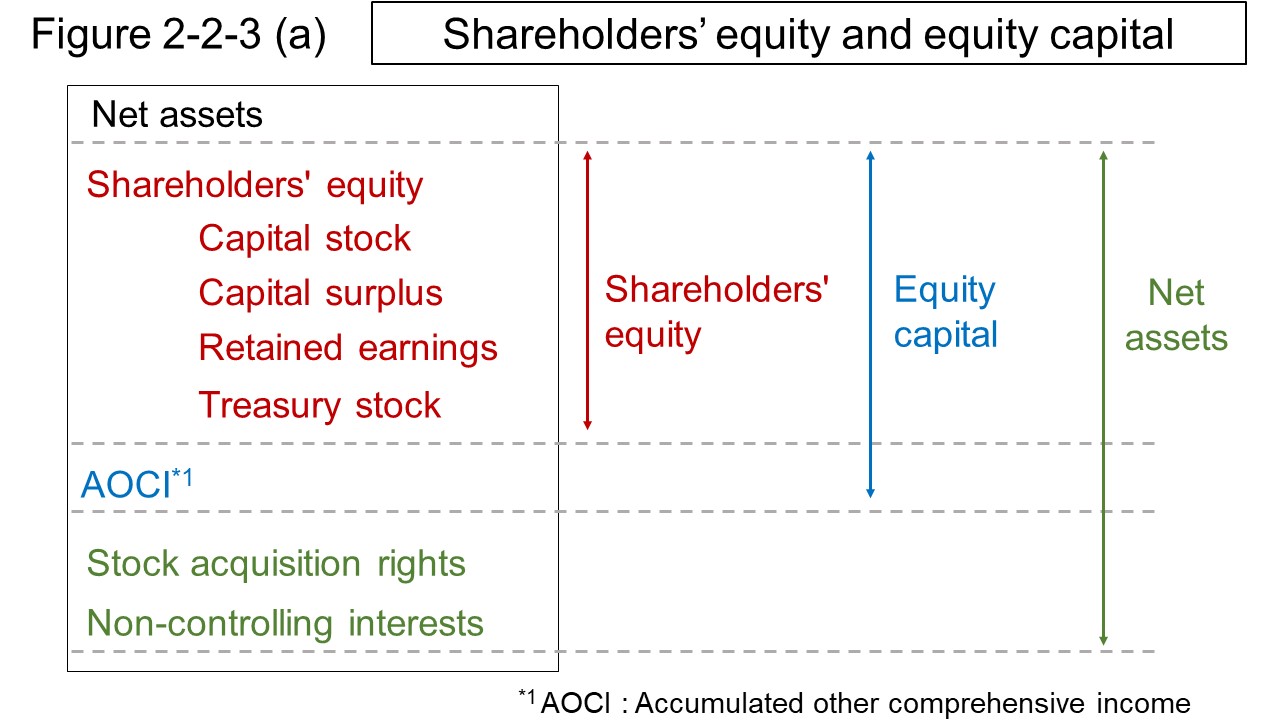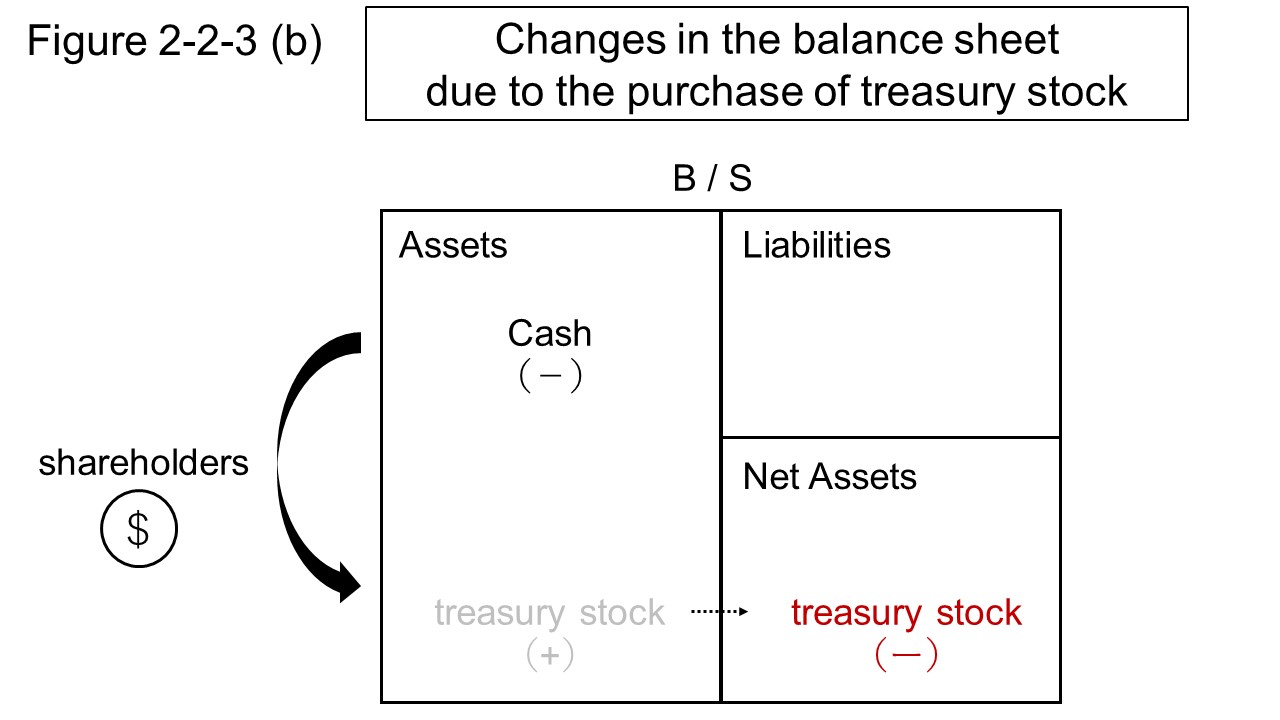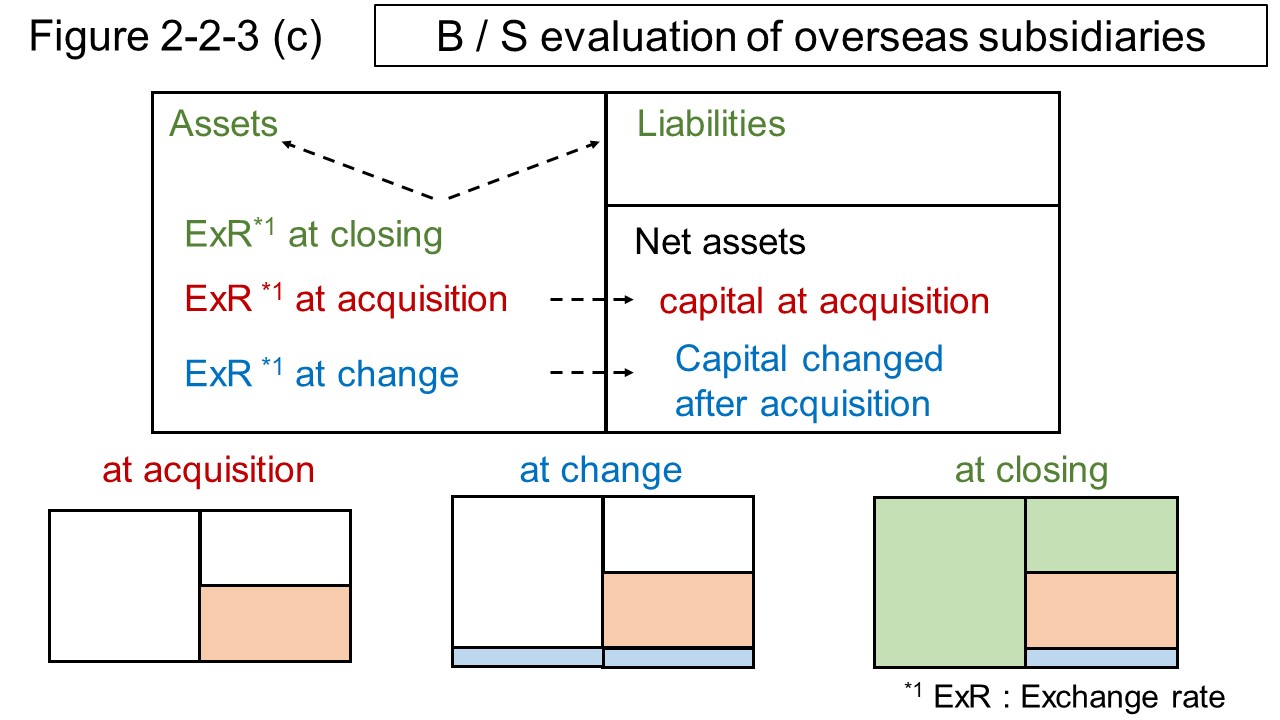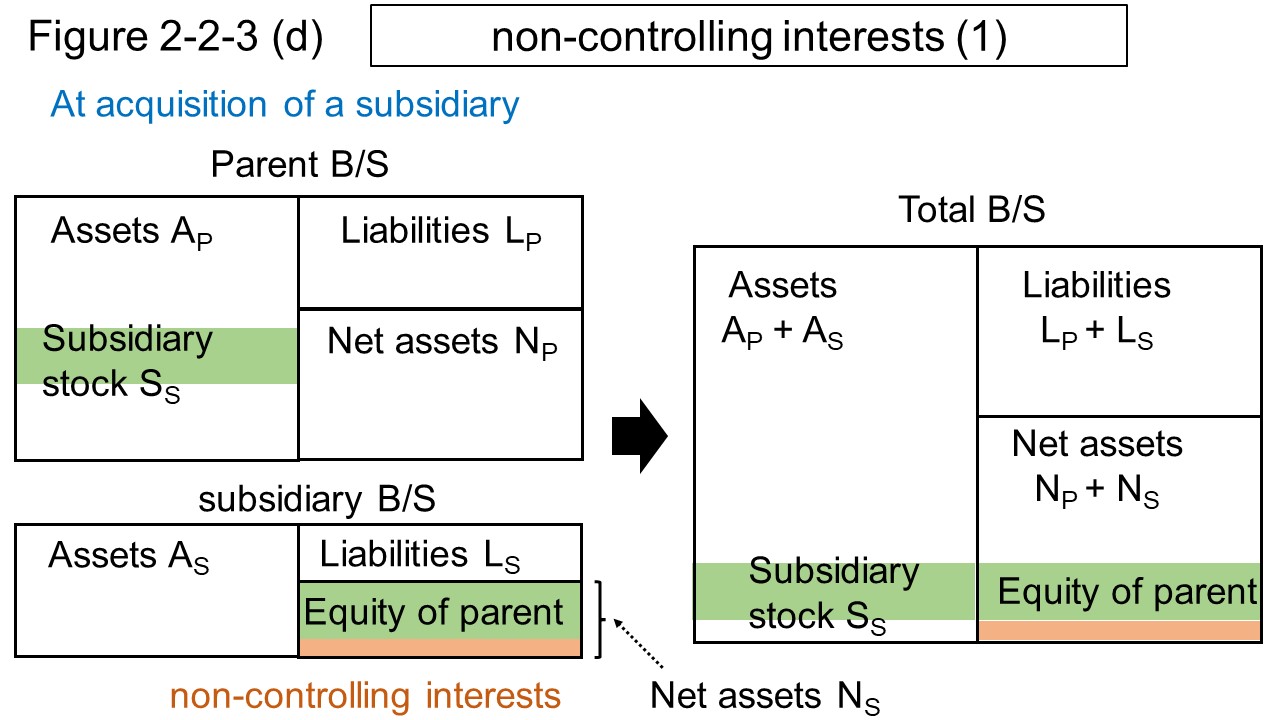This page describes the accounts of net assets on balance sheet.
It emphasizes understanding the meaning of accounts rather than specialized accounting knowledge.
On the balance sheet, Net assets are listed in the lower of right side.
In the upper of right side on the balance sheet, liabilities are listed.
The total amount of liabilities and net assets is called total capital.
Total capital is a term that describes how money was raised, which is a concept that contrasts with total assets.
However, not all accounts included in total capital are related to raising money.
Capital included in the shareholders' equity of net assets represents the funds procured from shareholders.
However, overall shareholders' equity reflects how the funds have changed due to the business, in addition to the funds raised from the shareholders.
And the total net assets reflects how total capital, the entire right side of the balance sheet, was managed
the entire right side of the balance sheet, that is, how total capital was operated.
That is, net assets reflect the results that the company raised funds and ran the business by operating the funds.
In addition, it also reflects how the company distributed the fruits of business.
- Net assets
- It is described "純資産", and called "jun shisan", in Japan.
Net assets is a part that is not included both in assets and liabilities on the balance sheet, which is the amount of assets minus liabilities.
Net assets can be broadly divided into shareholders' equity, accumulated other comprehensive income, subscription rights to shares, and non-controlling interests.
- Shareholders' Equity
- It is described "株主資本", and called "kabunushi shihon", in Japan.
- Equity Capital
- It is described "自己資本", and called "jiko shihon", in Japan.
Shareholders' equity represents the investment of shareholders and the accumulation of profits.
The details of the classification are as shown in the table 1.
Here, only the overview is dealt with, and the details are dealt with in the explanation of individual accounts.
| Capital stock | ||
| Deposit for subscriptions to shares | ||
| Capital surplus | Legal capital surplus | |
| Other capital surplus | ||
| Retained earnings | Legal retained earnings | |
| Other retained earnings | Voluntary retained earnings | |
| Retained earnings brought forward | ||
| Treasury stock | ||
When company based on equity receives investment from an investor, it receives capital in exchange for shares.
The capital is used for the assets and expenses required for the business, and the capital is listed as capital stock on the right side of the balance sheet.
As will be described later, part of the capital stock can be legal capital surplus.
Among the capital, the stocked portion is the capital stock, and the surplus portion is the capital surplus.
And, among the profits generated from the business after the establishment of the company, the portion held by the company without distribution are retained earnings.
The surplus from capital transactions is capital surplus, and the surplus from profit and loss transactions is retained earnings.
In addition, capital surplus and retained earnings are categorized as "Legal" and "Other", respectively.
"Legal" items are obliged to be reserved in order to protect creditors, and "Other" items are the residue of "Legal" items.
By the way, there are similar concepts of shareholders'equity and equity capital, but they are not the same.
Figure 2-2-3 (a) shows the difference between shareholders' equity and equity capital.

As shown in Figure 2-2-3 (a), equity capital means the shareholder's share, which includes shareholders' equity and accumulated other comprehensive income.
In other words, equity capital is the portion of net assets that belong to current shareholders, excluding subscription rights to shares and non-controlling interests among net assets.
That is, equity capital is the portion of net assets that is considered to belong to shareholders, which includes not only the profit realized through capital transactions and profit and loss transactions, but also unrealized valuation gains and losses.
Net assets can be broadly divided into shareholders' equity, accumulated other comprehensive income, subscription rights to shares, and non-controlling interests.
As mentioned above, the portion of net assets that is considered to belong to shareholders is the portion of equity capital.
Shareholders' equity represents the investment of shareholders and the accumulation of realized profits.
Profit is generated by capital transactions and profit and loss transactions.
Shareholders' equity is divided into capital stock, capital surplus, retained earnings, and treasury stock.
Capital stock is all or a portion of the investment from shareholders.
Capital surplus includes the portion of the investment from shareholders that has not been included in capital stock, as well as profits generated from capital transactions.
Retained earnings is the accumulation of profits realized in profit and loss transactions.
Treasury stock is the amount of stock that has been bought back from shareholders by the company, among stock issued by the company.
- Capital stock
- It is described "資本金", and called "shihon kin", in Japan.
Capital stock is all or a portion of the investment from shareholders when the company is established or increased the capital.
Capital stock is required to keep the property equivalent to the amount in order to protect the creditors.
All investment may be capital stock, but the Companies Act stipulates the rules that the legal capital surplus can be up to 1/2 of that amount.
According to this rule, the investment from shareholders can be divided into capital stock and legal capital surplus.
Legal capital surplus is easier to withdraw than capital stock which must be keep the property because it has the meaning of reserve for future expenditures and losses.
In addition, smaller capital stock is advantageous in tax law.
Therefore, many companies do not use the all investment as capital stock, but allocate a part of it to legal capital surplus.
- Capital surplus
- It is described "資本剰余金", and called "shihon jyouyo kin", in Japan.
Capital surplus is surplus generated by capital transactions such as investment at the establishment of a company, issuance of shares in a capital increase, purchase and sale of treasury stock.
Capital surplus consists of legal capital surplus and other capital surplus.
- Legal capital surplus
- It is a portion of the investment used as a reserve
- Other capital surplus
- It is the surplus other than legal capital surplus among the surplus by capital transactions
Legal capital surplus is what a portion of a shareholder's investment is distinguished as a reserve for future large expenditures or losses at the time of company establishment or capital increase.
According to the rules of the Companies Act, the capital reserve can be up to 1/2 of the investment.
Other capital surplus is capital surplus generated in other capital transactions such as gain on disposal of treasury stock.
The corporate accounting principle stipulates the distinction between transactions related to capital and the transactions related to profit and loss, and the surplus in capital transactions is to be other capital surplus.
Threfore, the surplus in capital transactions is to be other capital surplus.
However, if the capital surplus becomes negative, it is permitted to make up for it from the retained earnings.
Dividends are usually paid from retained earnings, but there are also dividends from capital surplus in rare cases.
However, dividends on capital surplus are considered as capital gains, which are treated as incomes earned from selling stocks in tax law.
- Retained earnings
- It is described "利益剰余金", and called "rieki jyouyo kin", in Japan.
Retained earnings are the accumulation of profits generated from a company's profit and loss transactions.
Retained earnings consist of legal retained earnings and other retained earnings.
The outline of legal reserve and other retained earnings is as follows.
- Legal retained earnings
- It is a part of the dividend which is used as a reserve for the purpose of protecting creditors.
- Other retained earnings
- It is surplus other than legal retained earnings among the surplus in profit and loss transactions
Legal retained earnings is a part of the reserves that a company accumulates to protect its creditors as it pays dividends.
The Companies Act and its rules stipulate that a company must record 1/10 of the dividend amount as legal reserve until it reaches at least 1/4 of the capital stock.
Other retained earnings are the portion other than the legal reserve among the profit generated from the profit and loss transactions.
Other retained earnings are divided into voluntary retained earnings and retained earnings brought forward.
| Retained earnings | Legal retained earnings | |
| Other retained earnings | Voluntary retained earnings | |
| Retained earnings brought forward | ||
Voluntary retained earnings is a reserve that the company can accumulate for a limited purpose at its own discretion, and the other portion of other retained earnings is the retained earnings brought forward.
Dividend of surplus is usually distributed from this retained earnings brought forward.
- Treasury stock
- It is described "自己株式", and called "ziko kabushiki", in Japan.
Treasury stock is the stock that the company has bought back from its shareholders.
Purchasing treasury stock means paying back cash to shareholders and buying back the same amount of stock.
At that time, the amount of cash payments will be reduced from the assets and the treasury stock will be included in the shareholders' equity, so the treasury stock will be a negative account on the balance sheet, as illustrated in Figure 2-2-3 (b).

Whether it is a dividend or a share buyback, shareholders' equity will be reduced by the amount paid and the shareholders will receive that amount.
Therefore, they are the same in terms of returning profits to shareholders.
However, for investors, while dividends are taxable, share buybacks have the advantage of supporting stock prices by using retained earnings tax-free.
It is often thought that the cancellation of treasury stock will increase the value per share because the total number of issued shares will decrease.
However, if the company purchased at a price above fair value, the total number of issued shares will not decrease as much as the amount of cash paid to shareholders by the cancellation.
Therefore, the shareholder value will not increase unless the company purchase them at a price lower than the appropriate price.
- Accumulated other comprehensive income
- It is described "その他の包括利益累計額", and called "sonota no houkatsu rieki ruikei gaku", in Japan.
Comprehensive income is valuation gain or loss that is not counted in the income statement.
Realized gains / losses are incorporated into shareholders' equity as net income, while unrealized gains / losses are incorporated into other comprehensive income as other comprehensive income.
As a result, net assets increase or decrease depending on comprehensive income, which is the sum of net income and other comprehensive income.
The relationship between accumulated other comprehensive income on the balance sheet and other comprehensive income in income statement is shown in Figure 2-1 (e).
- Valuation difference on available-for-sale securities
- It is described "その他有価証券評価差額金", and called "sonota yuuka syouken hyouka sagaku kin", in Japan.
Available-for-sale securities are securities that do not fall under any of trading securities, HTM securities, shares of subsidiaries and associates.
For example, long-term stocks held for the purpose of profitability or strengthening business relationships are classified as other securities because they do not meet any of the above three conditions.
Available-for-sale securities need to be recorded as market value at the closing, so it change the total assets.
Since net assets also need to change accordingly, the account for adjusting the balance is the "valuation difference on available-for-sale securities".
However, the difference in the valuation difference is not directly changed by the market value of the assets, it is adjusted after processing them in tax effect accounting.
- Deferred gains or losses on hedges
- It is described "繰延ヘッジ損益", and called "kurinobe hedge soneki", in Japan.
Deferred gains or losses on hedges on the balance sheet is what the profit / loss of the hedging instrument have been deferrd until the profit / loss of the hedged object is realized.
Most companies operate their businesses by buying and selling goods such as raw materials and commodities.
However, if the price of the goods handled cahge highrer, it will have a significant impact on management.
Therefore, hedging transactions may be carried out in order to reduce the influence of price changes of the goods.
For example, even if crops (hedging items) are cultivated, there is a possibility of loss depending on the market price at the time of sale.
However, if a short hedge (hedging means) is used for commodity futures, even if the hedged item drops in price and a loss occurs at the time of sale, by closing the hedging means, the difference will be the profit equivalent to the expected selling price.
When a balance sheet is created between the planting and sale of this crop, the hedged crop will not be counted as market value, but the hedged commodity futures will be counted as market value.
So, since the short hedge is not settled until the profit / loss of the hedge item is confirmed, the valuation profit / loss will not be realized.
In this case, by deferring the profit / loss of the hedging instrument as "deferred gains or losses on hedges" until the profit / loss of the hedged item is confirmed, the balance sheet will always be balanced.
- Foreign currency translation adjustment
- It is described "為替換算調整勘定", and called "kawase kansan tyousei kanjyou", in Japan.
Foreign currency translation adjustment on the balance sheet is an account for adjusting the defference caused by using multiple exchange rates when converting the financial statements of overseas subsidiaries into yen.
The balance sheet of overseas subsidiaries is to be converted into yen according to the following rules.
- For items that belong to the capital at the time of acquisition, the exchange rate at the time of acquisition is used.
- For items that belong to the capital that have changed after acquisition, the exchange rate at the time of capital change is used.
- For assets and liabilities, the exchange rate at the time of closing is used.
Figure 2-2-3 (c) illustrates the exchange rates used to evaluate the balance sheets of overseas subsidiaries.

Under this rule, even if the balance sheet of an overseas subsidiary does not change at all on a dollar basis, if the exchange rate at acquisition and the exchange rate at closing are different, the balance sheet will not be balanced.
Like this,the account that adjusts the defference caused by applying different exchange rates according to the items on the balance sheet is "foreign currency translation adjustment".
Foreign currency translation adjustment on the statement of comprehensive income is the adjustment of the defference for that period, and accumulation of that is foreign currency translation adjustment on the balance sheet.
- Remeasurements of defined benefit plans
- It is described "退職給付に係る調整累計額", and called "taisyoku kyuuhu ni kakaru tyousei ruikei gaku", in Japan.
"Remeasurements of defined benefit plans" on the balance sheet is the accumulation of "remeasurements of defined benefit plans" on the statement of comprehensive income.
“Net defined benefit liability” in the consolidated financial statements is "projected benefit obligation minus pension assets”, while “provision for retirement benefits” in the individual financial statements is “projected benefit obligation minus pension assets minus unrecognized items”.
That is, unrecognized items are not considered in the "provision for retirement benefits" in the individual financial statements.
It is "remeasurements of defined benefit plans" on the statement of comprehensive income that adjusts for this difference.
And, the accumulation of that is "remeasurements of defined benefit plans" on the balance sheet.
- Subscription rights to shares
- It is described "新株予約権", and called "shin kabu yoyaku ken", in Japan.
Subscription rights to shares is the right to receive the shares of the company that issued the stock acquisition rights securities.
You can receive shares by exercising subscription rights to shares, but you do not always have to.
The shares received may be treasury stock and are not necessarily new shares.
There are many types of subscription rights to shares, such as for internal use (stock options), for external investors, and for existing shareholders (free allotment).
Stock options are stock acquisition rights that allow employees and directors to purchase their own shares at a fixed price, and are often used to provide incentives.
subscription rights to shares for outside investors are primarily for the purpose of raising funds.
There are also subscription rights to shares that are distributed free of charge to existing shareholders when there is concern about dilutive stock.
- Non-controlling interests
- It is described "非支配株主持分", and called "hi shihai kabunushi mothibun", in Japan.
Non-controlling interests are interests that belong to minority shareholders in the capital of a consolidated subsidiary.
If it is not a wholly owned subsidiary of the parent company, the subsidiary has shareholders other than the parent company.
Such shareholders who do not control the subsidiary are called non-controlling shareholders.
When preparing the consolidated financial statements, it is necessary to offset the subsidiary stock recorded in assets and the subsidiary equity recorded in net assets after the sum of the subsidiary financial statements, as shown in Figure 2-2-3 (d).
As a result of the offset, the minority interests of the subsidiary remaining in the net assets of the consolidated balance sheet are "non-controlling interests".

